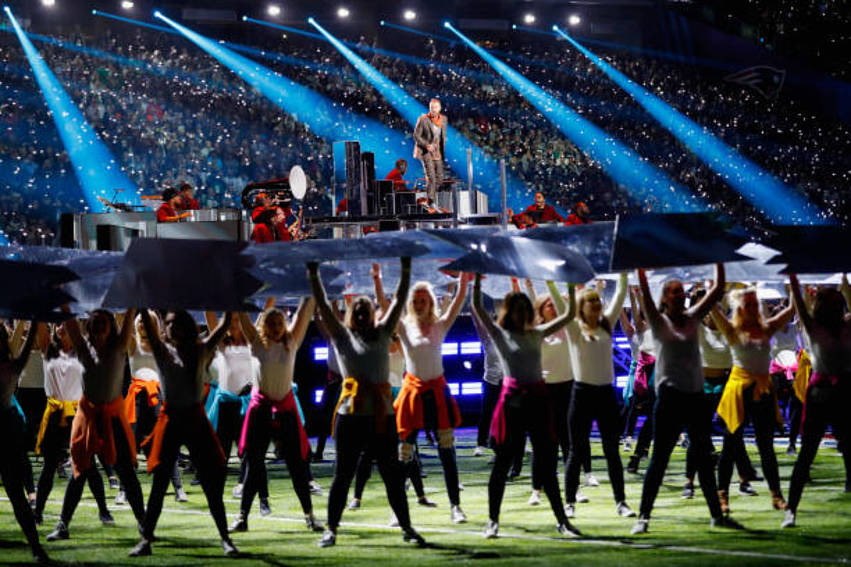This weekend, all eyes will be on Maroon 5 as they headline the Super Bowl LIII Halftime Show. While the game itself generates plenty of excitement, feelings are often a little more mixed about the halftime show.
History and Hiccups of the Super Bowl Halftime Show
To see what you can expect from this year’s halftime show, check out Juwan’s predictions for Super Bowl LIII.
The History of Halftime
The NFL’s Super Bowl is essentially the center of the American television, entertainment, music, and sports world every year: It crowns the champion of the American football world at the end of the competition, receives millions in revenue for coveted advertisement spots during commercial breaks, and puts on the most popular concert of the year in the Super Bowl Halftime Show. While there has always been a halftime show since the inception of the Super Bowl — the Grambling State University band has the most appearances with six — it became a universally coveted 12-minute set when Michael Jackson took it during Super Bowl XXVI in 1993. There have been many performances and presenters of the show — some legendary, some infamous, some embarrassing — but the editions produced by the NFL, Ricky Kirshner, and Pepsi since they took over in 2007 (directed by Hamish Hamilton since 2010) have allowed them to grow and maintain the legitimacy and power the show has.
Following Justin Timberlake, who returned last year as the headliner at Super Bowl LII, California-originating band Maroon 5 is leading this year’s show at Super Bowl LIII in Atlanta, Georgia. The band, led by The Voice coach Adam Levine, is a natural for the halftime show, which has had some of the most successful and best performances ever seen — such as Prince performing “Purple Rain” in the unexpected rain; Diana Ross flying away on a helicopter; U2 leading the crowd through the unifying “Where the Streets Have No Name” months after the devastating September 11th, 2001 terrorist attacks, projecting the victims’ names onstage; Beyoncé bringing out her Destiny’s Child bandmates when she first performed in the gig in 2013.
Controversy Afoot?
Since they performed at the Super Bowl XLV Pregame Show in 2011, many expected Maroon 5 to get a go at the Halftime gig eventually — but this may not have been the best year for them to take it. Following the reactions to the politicized message behind Beyoncé’s “Formation” performed during her second Halftime performance in 2016 alongside Coldplay and Bruno Mars, and the subsequent alleged blackballing of Colin Kaepernick from the league, the NFL has attempted to avoid any overtly political messages or performers.
On the other hand, many outspoken artists have also avoided being considered for the gig due to the league and their team owners’ political stances so they can stand in solidarity with Kaepernick’s protest of police brutality and violence. The NFL notably, and publicly, was passed over by the likes of JAY Z, Cardi B, Rihanna, Lauryn Hill, Adele, and P!nk before they landed on Maroon 5, and they were both immediately met with backlash. It doesn’t help that the NFL does not pay performers, and even has asked performers to pay them in order to perform during their halftime gig. Many also felt the league intentionally overlooked many hip-hop artists, especially those from Atlanta, to go with yet another pop/rock act.
The league could not convince many artists to cross the boycott lines to appear at the show before they finally announced Travis Scott and Atlanta native Big Boi had joined the show, even though that did not quiet much of the furor. (Atlanta natives Gladys Knight and Chloe & Halle Bailey will also partake in Super Bowl festivities with renditions of the national anthem and “America the Beautiful,” respectively.)
In fact, Scott and the NFL pledged $500,000 to the social justice nonprofit Dream Corps, followed by the NFL, Maroon 5 and Interscope Records making a donation in the same amount to Big Brothers Big Sisters of America, in an effort to quiet the negative reception around the show. Still, another petition appealing to Adam Levine’s record as an activist made the rounds of the internet asking the band to turn down the gig.
Past Halftime Controversies
The reception is similar to how Timberlake’s announcement was received last year, considering he was a white pop singer performing in funk-centric Minneapolis two years after the “Formation” performance and Kaepernick collusion issues, but also due to his part in the 2005 Wardrobe Malfunction with Janet Jackson, which led to a media blacklisting of Jackson while Timberlake was allowed to continue his career and return to the show — for a third time — 13 years later.
News of his decision to perform with a Prince hologram (it turned out to be a projection of the singer, supported by Prince collaborator Sheila E.) also broke a week before his show to mostly negative reception, since the singer and Timberlake did not appear to have a positive relationship before Prince’s death in 2016.
Those past issues and the negative reception to this year’s show influenced the NFL to cancel this year’s Halftime show press conference, which every artist since Michael Jackson had done in some form or fashion (Prince did a 10 minute performance while answering no questions and Beyoncé did the “Star Spangled Banner” acapella) and led to even the WWE to mock them.
Levine opted to partake in a single one-on-one interview with Entertainment Tonight that will air during Sunday’s pre-game festivities.
Main Image Credit:

